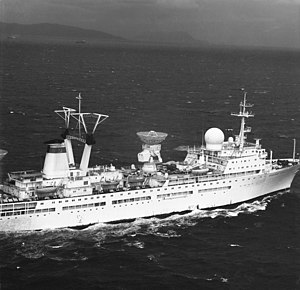Soviet ship Akademik Sergey Korolyov
 A starboard quarter view of the Soviet Korolev class civilian space associated ship Akademik Sergei Korolev underway. (1/1/1988)
| |
| Class overview | |
|---|---|
| Name | Korolev (Soviet Project 1908) |
| Builders | Black Sea Shipyard, Nikolayev |
| Operators | Academy of Sciences |
| Completed | 1 |
| Retired | 1 |
| General characteristics Akademik Sergei Korolev | |
| Type | SESS |
| Tonnage | 7,067 DWT |
| Displacement | 17,115 tons standard, 21,250 tons full load |
| Length | 596 ft (182 m) |
| Beam | 82 ft (25 m) |
| Draft | 26 ft (7.9 m) |
| Propulsion | 1 diesel (Bryansk/Burmeister & Wain); 12,000 hp (8,900 kW), 1 shaft |
| Speed | 17.5 knots (32 km/h) |
| Range | 22,500 nmi (41,670 km) at 16 knots (30 km/h) |
| Complement | approx. 190 + 170 scientist-technicians |
| Sensors and processing systems |
|
The Akademik Sergei Korolev (Template:Lang-ru) was a space control-monitoring ship constructed in 1970 to support the Soviet space program. Named after Sergei Korolev, the head Soviet rocket engineer and designer during the Space Race between the United States and the Soviet Union in the 1950s and 1960s, the ship also conducted upper atmosphere and outer space research.[1]
In Soviet times, the Akademik Sergei Korolev was a large communications ship which was part of a fleet of communications ships. These ships greatly extended the tracking range when the orbits of cosmonauts and unmanned missions were not within range of Soviet land-based tracking stations.[2] The ship mainly operated in the Atlantic Ocean monitoring spacecraft trajectory, telemetry data, and guaranteed a communications link with the cosmonauts.[3]
The ship had about 1200 accommodations, including 79 laboratories, in which 188 scientific workers performed their duties.[3]
In 1975, the ship was a part of the Soviet-American Apollo-Soyuz joint test program.[4]
Sold for scrapping and renamed OROL, arriving at Alang on 18th August 1996
See also
References
- ^ Norman Polmar, Guide to the Soviet Navy, Fourth Edition (1986), United States Naval Institute, Annapolis Maryland, ISBN 0-87021-240-0
- ^ a b Askar, Research ship Akademik Sergey Korolev (2006), Template:Ru icon Online, Accessed 6/14/2008
- ^ SP-4209 The Partnership: A History of the Apollo-Soyuz Test Project, (U.S.) NASA, Online Article
External links
- A. Karpenko, ABM and Space Defense, Nevsky Bastion, No. 4, 1999, pp. 2–47, Federation of American Scientists (Online)
